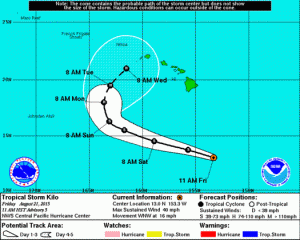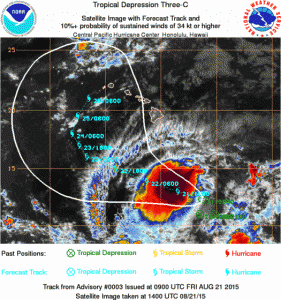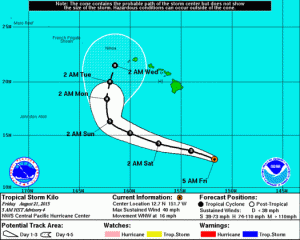11 p.m. UPDATE: Kilo Track Nudged Left
**Updated at 11 p.m.***
By Meteorologist Malika Dudley
As of the 11 p.m. CPHC update, Kilo still has maximum sustained winds near 35 mph with higher gusts. Gradual strengthening is expected with Kilo becoming a tropical storm once again by Saturday night.
The system is located 450 miles SSW of Hilo. Aircraft that have been sampling the storm this evening determined the center is located slightly southwest of where satellite imagery was leading forecasters to believe it was positioned. The track has therefore been nudged slightly to the left of the previous track.
The system is moving west-northwest near 16 mph and this general motion should continue through Saturday with a gradual decrease in speed expected. Sunday a turn to the northwest and more significant slowing in forward speed are forecasted. The track has also been adjusted based on these new estimates.
***Updated at 10 p.m.***
By Meteorologist Malika Dudley
Trade winds will turn southeasterly and weaken over the weekend. The very moist air mass over the state is expected to become moister still. Showers and thunderstorms could easily pop up in these types of conditions and especially as interaction occurs with the land through orographic lifting and daytime heating. In fact, we could see locally heavy showers as early as Saturday. The Flash Flood Watch currently in effect for Maui and the Big Island will very likely be expanded to the other islands.
Tropical depression Kilo is predicted to pass south of the state through the weekend, and then to strengthen as it turns back towards the islands early next week. The storm itself could bring even heavier rain depending on the path it takes. And remember the ground is likely to already be quite saturated which increases the potential for flooding. High winds and large surf are also distinct possibilities.
However, forecasters at the CPHC say the forecast will change significantly depending on the behavior of this storm.
If Kilo takes a sharp, early turn to the right, then most of the smaller islands will be at risk for damaging winds and rain on a scale not seen for decades. If Kilo turns right slowly enough, or continues straight to the northwest, then it may miss the islands and coastal waters altogether, sending mainly large swells in our direction. Most weather models suggest outcomes between these two extremes.
The National Weather Service is asking anyone expecting to be in or near the main Hawaiian islands through the next week to pay close attention to this developing situation. Although it is best to prepare for hurricane season before it starts, this would be a good time to review your plans and gather supplies you may need to ride out several days of damaging wind and surf, and very heavy rain.
***Updated at 5 p.m.***
By Meteorologist Malika Dudley
Kilo has weakened slightly and dropped below the tropical storm threshold to a Tropical Depression. Maximum sustained winds are at 35 mph with higher gusts. Gradual strengthening is expected the next couple of days.
At 5 p.m. the system is located 435 miles S of Hilo, 445 miles S of Kailua-Kona and 385 miles S of South Point.
The system is moving west-northwest near 14 mph and this general motion should continue over the next two days with a gradual decrease in speed expected early Sunday.
The system has become a little more disorganized on satellite. Easterly wind shear is helping to tear the system a part a bit. This makes the intensity forecast tricky for forecasters.
Over the next 48 to 60 hours the wind shear is expected to weaken and the system will be traveling over very warm waters which will act as fuel for the storm. The current forecast is less aggressive than past forecasts but still brings Kilo to hurricane status in about 3 days.
If Kilo continues to lose organization and does not develop enough deep convection at its center, Kilo could become a post-tropical remnant low. The Central Pacific Hurricane Center forecasters say this would be a surprising development but it is not entirely unheard of.
Hurricane Hunters and other data collection air missions are still on track for this evening and through the weekend. This will give us valuable information on the structure of the system, it’s center location and intensity.
As with all tropical systems, residents are urged to continue to keep a watchful eye on the weather forecast. Hurricane season runs through November 30th and historically, August is the peak month of the season. Make sure to be prepared throughout hurricane season.
WEATHER FORECAST –
Kilo will pass to our southwest this weekend, and a large area of moisture on the east side of the storm will be drawn northward up the island chain. This will increase the threat for heavy showers or thundershowers starting first near the Big Island late Saturday, and then spreading up the chain early next week. Details on the FLASH FLOOD WATCH are posted below in the 3:45 p.m. update.
National Weather Service forecaster, Bob Ballard, had this to say about our island weather.
What our weather does after this weekend depends a lot on what Kilo does. The threat for strong winds would be considerably less for the islands if it were to take a track on the left/west side of the CPHC uncertainty cone, but there would still be southerly flow advecting a lot of moisture over the islands to keep a chance of heavy showers and thundershowers over some areas. It seems fairly likely that at some point we will have to expand the flash flood watch, but prefer to wait on this since the timing details are still somewhat fuzzy. If Kilo were to track on the right side of the uncertainty cone at the official forecast intensity, we could be dealing with a hurricane on our doorstep in a several days.
***Updated at 3:45 p.m.***
By Meteorologist Malika Dudley
The National Weather Service has issued a Flash Flood Watch for the island of Hawaii in anticipation of widespread rain expected this weekend.
The watch will go into effect at 6 p.m. Saturday and will be posted through 6 p.m. Monday.
A large area of moisture to the east of tropical storm Kilo is expected to spread across Maui and the Big Island. As the deep tropical moisture interacts with the land, flooding is possible due to heavy, slow-moving rainfall episodes.
The watch could be expanded for a longer period of time and to other islands. It all depends on the eventual track and intensity of Kilo.
The National Weather Service advises the public to keep a close eye on the weather forecast this weekend. We will be updating the website with the latest as the situation unfolds.
A Flash Flood Watch means that conditions may develop that lead to flash flooding. Flash flooding is very dangerous. Never drive into areas where water covers the road.
***Updated at 1:30 p.m.***
By Meteorologist Malika Dudley / Email: [email protected]
The latest forecast calls for Tropical Storm Kilo to pass south of the islands this weekend. This will likely cause our wind flow to gradually turn back toward the southeast making conditions muggy and hot once again.
A large area of deep tropical moisture to the east of the tropical storm is expected to spread over the islands this weekend, returning more showers to the state as well. Localized excessive rainfall is possible this weekend as conditions once again become favorable for downpours and a few thundershowers.
The forecast details for early next week remain highly dependent on the eventual track and intensity of Kilo. The threat for strong winds would be considerably less for the islands if it were to take a track on the left/west side of the cone, but there would still be considerable moisture for the chance of heavy shower bands over some areas. A faster recurvature near the islands with a track on the far right side of the cone could result in direct impacts to the western main islands from what is then forecast to be Hurricane Kilo.
***Updated at 11:00 a.m.***
By Meteorologist Malika Dudley
Not a lot has changed since the last update on Kilo. Winds are still at 40 mph and easterly shear seems to be keeping it in check for the moment.
The storm is now located 480 miles south-southeast of Hilo.
Forecast guidance listed below (5 a.m. update) still holds true with less shear expected and warm sea surface temperatures expected to help the system become more organized and strengthen over the next few days.
The track has been nudged about slightly, as with all of these tropical systems, it will continue to shift around as the system progresses and more data is collected.
***Updated at 5:30 a.m.***
By Meteorologist Malika Dudley
Tropical Depression Three-C has strengthened into a Tropical Storm with the Hawaiian name, Kilo. Maximum sustained winds are at 40 mph with higher gusts. Gradual strengthening is expected the next couple of days.
The system is located 535 miles SSE of Hilo, 565 miles SSE of Kailua-Kona and 505 miles SSE of South Point. Tropical storm force winds extend 115 miles from the center.
The system is moving west-northwest near 16 mph and this general motion should continue over the next two days with a gradual decrease in speed expected Sunday.
The system has grown in size since the last advisory was issued and become a bit more organized on satellite. Kilo is moving over very warm water and easterly wind shear (which would help to weaken the storm if it were strong enough) is expected to weaken. These factors suggest that the system should strengthen. The latest weather model runs are showing that happening a bit slower than they did in the last update.
Hurricane Hunters are expected to make their first pass through the system Friday evening. This will provide us with valuable information and data on the storm.
Another aircraft is expected to conduct a mission Saturday morning in order to sample the strength of the ridge to the north of Kilo. This knowledge will help us figure out when exactly the system is expected to slow in forward speed and take a turn to the north-northeast. The track will be adjusted accordingly.
The National Weather Service’s latest forecast discussion says, based on last night’s CPHC advisory, there is a possibility for tropical storm conditions to develop on Niihau, Kauai and Oahu in the Monday night to Tuesday time frame. In addition to the wind threat, rainbands and embedded thunderstorms extending well to the east of the track of the system may affect the islands.
Trade wind weather is expected to be short-lived as winds turn more southeast over the islands beginning tonight through the rest of the weekend as Kilo tracks further west-northwest. Our weather is expected to become increasingly influenced by the track and intensity of the system. Latest models still show a surge of deep moisture from the southeast on the backside of the system affecting the islands beginning tonight. This will likely bring more showers to the state. Winds may further increase as well.
It is very important to consider that forecasts at longer ranges have a large margin of error, with an average of nearly 300 miles at 5 days, and roughly 200 miles at 4 days. Do not get hung up on any precise track. Always consider alternate possibilities using both the error cone and wind speed probabilities and be prepared as needed.




















